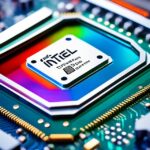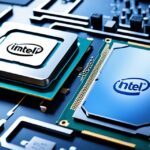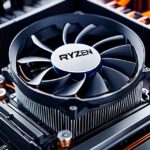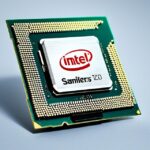Table of Contents
In the modern tech world, overclocking is a top choice for boosting CPU performance. It’s crucial for gamers and professionals who want more from their computers. Overclocking makes processors, like Intel’s Core series with a “K” suffix (e.g., Intel Core i5-14600K) or AMD’s Ryzen, operate faster than their official speeds. This offers a noticeable improvement in how well they perform12. This guide will show you how to check if your CPU is running beyond its intended speeds. You’ll learn to spot an overclocked CPU and understand what risks this might bring.
Key Takeaways
- Overclocking enables CPUs to achieve speeds beyond their default specifications.
- Intel and AMD each have specific processors that support overclocking.
- Utilising appropriate tools and techniques can enhance performance significantly.
- Monitoring temperatures is crucial to prevent overheating during tests.
- A stable motherboard and adequate cooling are essential for successful overclocking.
Understanding Overclocking Basics
Overclocking means making a CPU work faster than its original settings. It’s popular with tech fans and gamers for the speed boost it gives. Benefits of overclocking can be huge, especially for heavy-use apps or games. It can really improve performance when done right.
What is Overclocking?
Overclocking is about changing CPU settings to increase its speed. You can adjust the CPU’s multiplier or bus speed to get higher speeds. For example, overclocking has pushed CPUs like the Intel Core i9-13900K past 9 GHz3.
Why Do Users Overclock Their CPUs?
Users overclock to get more power from their CPUs. This can boost performance by 15% to 30% or even more3. This is very useful for tasks like video editing or gaming. Yet, it’s important to think about the risks of overclocking. Doing it wrong can overheat your system or make it unstable.
Potential Risks of Overclocking
However, overclocking can also have downsides. It can cut a CPU’s life from 20 years to 10 to 15 years3. Bad cooling can make things worse, causing serious problems like the Blue Screen of Death4. So, while the benefits of overclocking are appealing, it’s key to do it wisely.
Identifying Stock Clock Speeds
Knowing your CPU’s stock clock speed is key to see if it’s been overclocked. The stock clock speed is the frequency the manufacturer sets for normal operation. Check the CPU model first to find this information. This helps you know if your CPU’s performance matches the expected benchmarks.
Finding the Specifications of Your CPU
To find your CPU’s specs, identify its model. You might need to look in your system’s settings or use tools like CPU-Z. These details will show the stock clock speed, in gigahertz (GHz). This helps you decide if your CPU runs as it should or if it’s overclocked.
Common CPU Models and Their Stock Speeds
Different CPUs have different standard speeds. For example, AMD Ryzen processors have speeds that meet most needs. Intel’s K-series CPUs can be overclocked for faster speeds. Here’s a table of common CPUs and their speeds:
| CPU Model | Stock Clock Speed (GHz) |
|---|---|
| AMD Ryzen 5 5600X | 3.7 |
| Intel Core i7-11700K | 3.6 |
| AMD Ryzen 7 5800X | 3.8 |
| Intel Core i9-11900K | 3.5 |
Knowing these stock clock speeds helps you check if your system works right. It’s crucial for tuning performance or getting into overclocking. Overclocking pushes beyond normal speeds, offering rewards and risks567.
How to Tell If CPU is Overclocked
To find out if your CPU is overclocked, focus on certain metrics and use the right tools. System monitoring tools help you see how your CPU is doing in real time. You can then compare these speeds to what the maker says they should be.
Using System Monitoring Tools
Tools like Task Manager, CPU-Z, and GPU-Z come in very handy. They let you keep an eye on your CPU’s Core Speed, Multiplier, and Bus Frequency. This makes it easy to see if these numbers are higher than the default speeds.
Take the Intel i9-10900K, which normally runs at 3.70 GHz but can hit 5.30 GHz when boosted8. By looking at this data, you can tell if your CPU is working harder than it’s supposed to.
Performing Benchmarks for Reference
Running CPU benchmarks is a solid way to check for overclocking effects. These benchmarks can show you how much faster your CPU is working compared to normal. For example, some benchmarks show a 36% rise in speed9. This data helps you understand if your CPU’s performance is due to being overclocked.
Checking Clock Speeds with Software Tools
It’s important to monitor your CPU’s clock speed if you’re into overclocking. There are software tools that let you check and analyse performance. They help you see if your CPU works beyond its normal settings.
Using CPU-Z for Clock Frequency
CPU-Z is crucial for keeping an eye on clock speeds and system info. It shows you the current clock speed and multipliers of your CPU. You can then tell if your CPU has been overclocked10. Using CPU-Z often helps you get better at tuning your CPU for top performance.
Using GPU-Z to Analyse GPU Overclocking
Don’t forget about your GPU when checking performance. GPU-Z gives detailed info about your graphics card’s speeds and more. It helps track GPU performance, spotting any overclock that might upset system stability. With it, you can tweak settings for better gaming or heavy tasks.
Exploring Other Useful Tools like MSI Afterburner
MSI Afterburner is great for maximizing hardware performance. You can monitor and adjust CPU and GPU settings with it. Set custom fans, manage power, and keep an eye on temperatures. Using these tools keeps your system stable and cool. For tips on overclocking safely, check out this guide11.
Accessing the BIOS is crucial for tweaking CPU overclocking settings. This interface lets you adjust configurations that influence your processor’s performance.
Entering the BIOS Setup
Press DEL or F2 after powering up the computer to enter the BIOS setup. This opens the interface where you can adjust settings to improve CPU performance. Here, you can find critical BIOS settings for effective overclocking.
Locating CPU Frequency and Multiplier Settings
Once inside the BIOS, finding the CPU frequency and multiplier settings is key. These options control your CPU’s speed, and tweaking them can boost performance. Exercise caution, though, as too high settings, especially voltages above 1.4 without proper cooling, can cause damage.
Always monitor to keep your CPU temperature under 65 degrees Celsius when doing heavy tasks12. It’s also wise to check CPU usage is below 10% in Task Manager before adjustments12.
Evaluating the Effects of Overclocking on Performance
To really boost your system’s ability, it’s crucial to know how to check performance after overclocking. By looking at different ways to measure performance, you’ll find where you can get better. Plus, you’ll see how well your CPU holds up when it’s working hard.
Performance Metrics to Consider
When you’re evaluating CPU performance after pushing it harder, several important factors come into play:
- Clock Speed: This is measured in gigahertz (GHz). A higher clock speed means your computer can do tasks faster, boosting how well it works13.
- Temperature: Pushing your CPU harder makes it hotter. It’s really important to use good cooling to stop it from overheating14.
- Stability: Making your CPU run faster should be followed by tests. This makes sure your computer runs smoothly without any issues14.
When to Revert to Stock Settings
Sometimes, after seeing the perks of pushing your CPU further, you might need to turn things back. For example:
- If your computer starts acting up or crashing a lot, going back to original settings can make it work right again.
- If it gets too hot, it’s better to slow down to keep everything working longer.
- When you’re not really seeing better performance, the potential risks might not be worth it13.
Conclusion
Understanding CPU overclocking is a careful path. You must weigh the benefits and risks carefully. This guide has shown the important steps to see if your CPU can be overclocked and how to boost CPU performance safely. Make sure you research and watch your settings closely to avoid overclocking problems1516.
To improve your computing experience, you need to check a few things. See if you have an unlocked CPU, if your motherboard supports overclocking, and if your cooling system is enough. Also, regularly check your CPU’s temperatures with trusted software tools. This will help keep your system stable while you push your hardware further15.
Learning the right balance for overclocking and following the best practices is key to upgrading your system safely. Embracing the thrill of faster performance is great, but being aware of the overclocking risks and benefits is crucial. For more advice on this complex topic, check out this useful guide on how to assess CPU overclocking capabilities1516.
FAQ
How can I tell if my CPU is overclocked?
To see if your CPU is overclocked, check your CPU’s clock speed. Use tools like Task Manager or CPU-Z. Then compare this speed to the standard specs found online.
What are the benefits of overclocking my CPU?
Overclocking boosts performance, increases processing speeds, and enhances gaming. It pushes hardware to achieve higher frame rates and smoother play.
Are there any risks associated with overclocking?
Indeed, overclocking can lead to more heat, system instability, and even damage. It’s vital to watch temperatures and stability closely.
How do I find my CPU’s stock specifications?
Find your CPU’s basic specs on the manufacturer’s website. Or use a search engine to find details for your model.
What is the best software for checking CPU speeds?
CPU-Z is top-rated for checking CPU speeds. GPU-Z is great for GPU overclocks. MSI Afterburner also offers performance monitoring.
How do I access the BIOS to check overclocking settings?
Access the BIOS by pressing keys like DEL or F2 as your computer starts. Look for CPU frequency and multiplier settings in the BIOS to see overclock adjustments.
What performance metrics should I monitor after overclocking?
After overclocking, watch the processing speed, temperatures, and stability. These metrics help ensure your overclocking is effective and safe.
When should I revert to stock settings after overclocking?
If you face instability, too much heat, or lacking performance, consider going back to standard settings. Regular checks help decide if overclocking is worth it.
Source Links
- https://www.lenovo.com/us/en/faqs/intel/overclocking-intel-processors/ – How to Overclock Intel Processors (CPU)
- https://www.xda-developers.com/how-to-overclock-cpu/ – How to safely overclock your CPU: A beginners guide to unlock more performance
- https://www.codecademy.com/resources/blog/how-to-overclock-cpu/ – How to (Safely) Overclock a CPU
- https://www.malwarebytes.com/cybersecurity/computer/what-is-overclocking – What is Overclocking? | Malwarebytes
- https://www.avast.com/c-how-to-overclock-cpu – How to Safely Overclock Your CPU for PCs & Laptops
- https://www.pcworld.com/article/406279/how-to-overclock-your-pcs-cpu.html – How to overclock your PC’s CPU
- https://www.digitaltrends.com/computing/how-to-overclock-your-cpu/ – How to overclock CPU safely with XTU, Ryzen Master, or BIOS | Digital Trends
- https://www.makeuseof.com/ways-to-check-if-cpu-gpu-overclocked/ – 3 Ways to Check If Your CPU or GPU Is Overclocked
- https://en.wikipedia.org/wiki/Overclocking – Overclocking
- https://ms.codes/en-gb/blogs/computer-hardware/how-to-know-if-my-cpu-is-overclocked – How To Know If My CPU Is Overclocked
- https://medium.com/@swipets86/how-to-tell-if-cpu-is-overclocked-properly-ultimate-guide-cac3704bf394 – How to Tell If CPU is Overclocked Properly: Ultimate Guide
- https://www.geeksforgeeks.org/how-to-overclock-your-cpu-from-bios/ – How to Overclock Your CPU from BIOS? – GeeksforGeeks
- https://www.avg.com/en/signal/how-to-overclock-cpu – Overclocking Your CPU: A Step-by-step Guide
- https://www.businessinsider.com/guides/tech/what-is-overclocking – What is overclocking? How to boost your PC’s speed and power by changing its CPU settings
- https://www.linkedin.com/pulse/unraveling-mysteries-cpu-overclocking-base-clock-vs-amr-elharony-tyhef – Unraveling the Mysteries of CPU Overclocking: Base Clock vs Multiplier 🎛️🔥
- https://www.techylop.com/why-is-my-cpu-overclocking-itself/ – Why Is My CPU Overclocking Itself – Need To Know In 2024!








